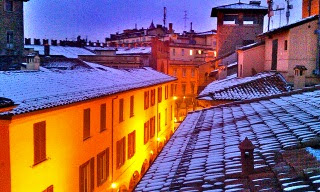Financial aid applications are due by February 15, 2013.
- Financial Aid: The Student Mosaic
- The cost of graduate school: Investing in your future
- Spending wisely
- Financial aid
Applicants to SAIS Bologna are asked to submit a complete financial aid form along with supporting documents. We will communicate scholarship awards at the same time as the admissions decisions -- by mid-March.
 SAIS Bologna offers generous amounts of financial support. Here is a link to our financial aid page. Non-U.S. applicants to SAIS Bologna should look at this page in particular for information on some of the scholarships administered by SAIS Bologna. (Note that the list is not exhaustive. There are several other grants that are not included as well as the funds that we set aside from our yearly budget.)
SAIS Bologna offers generous amounts of financial support. Here is a link to our financial aid page. Non-U.S. applicants to SAIS Bologna should look at this page in particular for information on some of the scholarships administered by SAIS Bologna. (Note that the list is not exhaustive. There are several other grants that are not included as well as the funds that we set aside from our yearly budget.)
If you think you meet the criteria for one or more of the grants listed, please be sure to mention it in the application form.
While we are proud of being able to help many students each year, we know that the money we have available is not enough to make everyone happy. For this reason, we recommend that students look for other sources of funding and use their creativity. Make a list of potential sources and be sure to reach out to all of them. Don't disregard small scholarships: every little does help. And don't give up.
In this document, you can find a list of institutions that have provided funding for our students in the past. (Please note that it will be up to you to ask about the application procedure, requirements and deadlines of these institutions.)
 SAIS Bologna offers generous amounts of financial support. Here is a link to our financial aid page. Non-U.S. applicants to SAIS Bologna should look at this page in particular for information on some of the scholarships administered by SAIS Bologna. (Note that the list is not exhaustive. There are several other grants that are not included as well as the funds that we set aside from our yearly budget.)
SAIS Bologna offers generous amounts of financial support. Here is a link to our financial aid page. Non-U.S. applicants to SAIS Bologna should look at this page in particular for information on some of the scholarships administered by SAIS Bologna. (Note that the list is not exhaustive. There are several other grants that are not included as well as the funds that we set aside from our yearly budget.)If you think you meet the criteria for one or more of the grants listed, please be sure to mention it in the application form.
While we are proud of being able to help many students each year, we know that the money we have available is not enough to make everyone happy. For this reason, we recommend that students look for other sources of funding and use their creativity. Make a list of potential sources and be sure to reach out to all of them. Don't disregard small scholarships: every little does help. And don't give up.
In this document, you can find a list of institutions that have provided funding for our students in the past. (Please note that it will be up to you to ask about the application procedure, requirements and deadlines of these institutions.)
As my colleague Nelson Graves said in a post last week, there is no one game plan. In fact, most students are able to make ends meet by combining different sources of funding. The key is to get started as early as possible.
Are there any questions you'd like to ask on this topic? If so, please comment on this post or write to admissions@jhubc.it.
Are there any questions you'd like to ask on this topic? If so, please comment on this post or write to admissions@jhubc.it.
We will post more on financial aid in coming weeks. In the meantime, below are the links to previous posts:
- The cost of graduate school: Investing in your future
- Spending wisely
- Financial aid


































